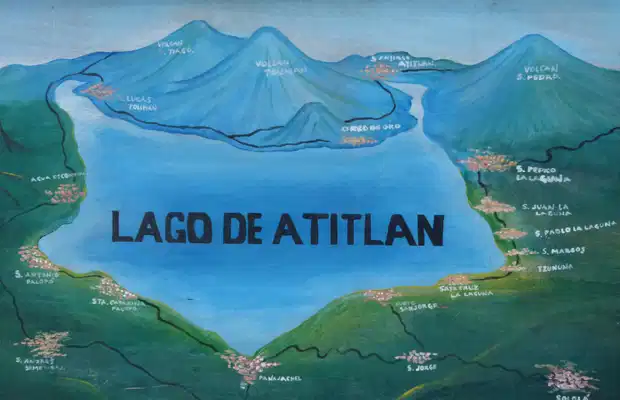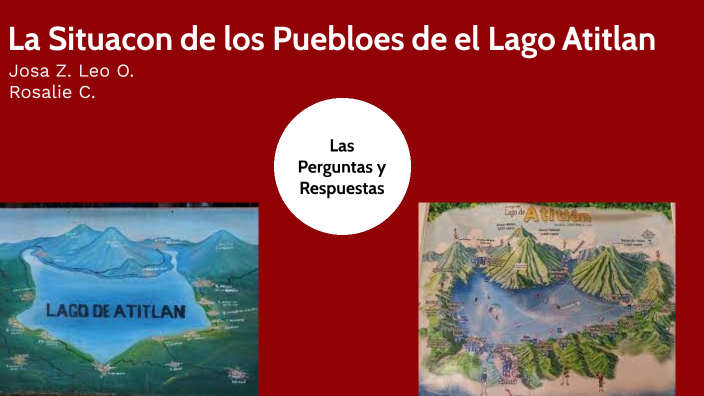Hi everyone! Let's talk about Lake Atitlán and the communities around it. It's a fascinating and important place.
What is Lake Atitlán?
Lake Atitlán is a lake in Guatemala. It is surrounded by volcanoes and Mayan villages. Imagine a beautiful, deep blue lake nestled amongst towering, green mountains. It's a sight to behold! It’s known for its stunning beauty and rich cultural heritage.
Think of it like this. You're looking at a postcard. It shows a perfect lake. Around the lake are small towns. They each have their own character.
Key Terms: People, Culture, Environment
We need to understand some key terms before we dive deeper. This will help us paint the whole picture of Lake Atitlán. It's important to know what we are talking about!
People: This refers to the people who live around the lake. Many are indigenous Maya people. They have their own languages, traditions, and ways of life. Think of it like different families in your neighborhood. Each family is a bit different.
Culture: Culture includes their beliefs, art, music, clothing, and customs. For example, the colorful textiles they weave are a big part of their culture. Or the way they celebrate certain holidays. It's their unique identity!
Environment: The environment is the natural world around the lake. This includes the water, the forests, the animals, and the volcanoes. The environment is what makes Lake Atitlán so special. Its health is critical for everyone living there.
The Villages around the Lake
Several villages are dotted around the shores of Lake Atitlán. Each village has its own unique flavor and identity. Some are more touristy, while others are more traditional. Let's learn about some of them.
Panajachel: Commonly called "Pana," is the gateway to the lake. This town is the most visited and largest of all the towns on Lake Atitlan. It's a bustling hub with markets, hotels, and restaurants. If you're arriving at the lake, you'll likely pass through here.
San Pedro La Laguna: Popular with backpackers, San Pedro offers stunning views. There are also Spanish schools and a relaxed atmosphere. It’s known for its nightlife and hiking opportunities. It's a favorite for those looking for adventure and budget-friendly travel.
Santiago Atitlán: This is the largest town on the lake. Santiago is rich in Mayan culture and traditions. It's known for its worship of Maximón, a folk saint. This is a unique cultural experience you will not find any where else.
San Juan La Laguna: This is a quieter, more traditional village. San Juan is known for its weaving cooperatives and medicinal plant gardens. It’s a great place to learn about Mayan traditions and support local artisans. You can also learn about natural dyes.
Santa Cruz La Laguna: Accessible only by boat or foot, Santa Cruz is a secluded village. It's perfect for those seeking peace and tranquility. It offers beautiful views and a chance to escape the crowds.
The Situation: Challenges and Opportunities
Living around Lake Atitlán isn't always easy. The communities face several challenges. But there are also opportunities for improvement and growth.
Environmental Issues: Pollution is a major problem. Runoff from agriculture and untreated sewage are contaminating the lake. This harms the ecosystem and threatens the water supply. Imagine if your local river was polluted with trash. It's a similar situation.
Poverty: Many people in the villages live in poverty. This makes it difficult to access education, healthcare, and other basic necessities. Poverty is also often linked to environmental degredation. People may engage in unsustainable practices to survive.
Tourism: Tourism can bring economic benefits. But it can also have negative impacts. Too many tourists can strain resources and disrupt local culture. Think about a popular tourist destination in your area. It's probably overcrowded sometimes.
Water Hyacinth: Lake Atitlán is battling a severe invasive species problem. The water hyacinth is rapidly multiplying, choking waterways, and impacting the native ecosystem. The plant can impact tourism and fishing because it makes it hard to get to the shore line.
Efforts to Help
Many organizations and individuals are working to address these challenges. They are striving to improve the lives of the people and protect the environment. They provide resources and support.
Environmental Conservation: Organizations are working to reduce pollution. They are promoting sustainable agriculture and improving waste management. This helps the lake and its communities.
Economic Development: Initiatives are helping people start their own businesses. This provides job opportunities and improves their standard of living. This can be anything from weaving to coffee growing to making ecotourism opportunities.
Education and Healthcare: Access to education and healthcare is being improved. This empowers people to make informed decisions and live healthier lives. This is very important because education and healthcare help people live productive lives.
Community Involvement: Local communities are actively involved in these efforts. They are the ones who know best what their needs are. They are working together to create a better future for Lake Atitlán. Think of it like your school trying to make your community better.
Why Should You Care?
The situation at Lake Atitlán is important for several reasons. The challenges faced there are similar to those faced by many communities around the world.
Global Issues: Environmental degradation, poverty, and cultural preservation are global issues. Understanding what's happening at Lake Atitlán can help us understand these issues better.
Interconnectedness: We are all interconnected. What happens in one part of the world can affect other parts of the world. Supporting sustainable development at Lake Atitlán is a way to contribute to a better world.
Learning Opportunity: Studying Lake Atitlán offers a valuable learning opportunity. We can learn about different cultures, different ways of life, and the challenges of sustainable development. We can also learn about the resilience of people.
Personal Growth: Engaging with the challenges faced by communities like those around Lake Atitlán can foster empathy and compassion. It can inspire us to become more active and engaged citizens.
In Conclusion
Lake Atitlán is a beautiful and culturally rich place. But it faces many challenges. By understanding these challenges and supporting efforts to address them, we can help create a more sustainable and equitable future for the communities around the lake. We can all make a difference!

